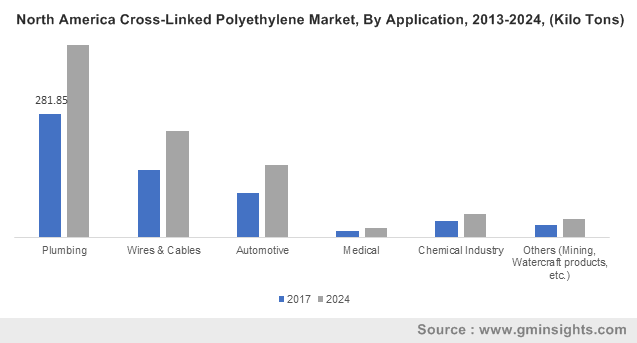Cross-linked polyethylene market to derive commendable proceeds via plumbing applications over 2018-2024, heaving infrastructure spending across Asia Pacific to drive industry growth
Publisher : Fractovia | Published Date : 2018-08-31Request Sample
Boasting of an extensive applicability across construction, automotive, chemical, and healthcare sectors, the cross-linked polyethylene market has been making its mark as one of the fastest growing niche verticals in the polymers and advanced materials industry in the recent times. Owing to various impressive properties like high chemical resistance, superior strength to withstand temperature fluctuations, and the capacity to resist gradual development of cracks, the cross-linked polyethylene materials are being increasingly recognized as effective alternatives to PVCs, CPVCs, and copper tubes in residential water pipelines. As a consequence, the plumbing application of the cross-linked polyethylene market has been expanding at an exceptional pace over the past few years.
North America Cross-Linked Polyethylene Market, By Application, 2013-2024, (Kilo Tons)

Moreover, these materials are being preferred over conventional materials to build pipes owing to easy installation and resistance to salts, acids, and moisture. In addition to this, these materials are being incorporated in the pipelines that transport sewage, slurries, and chemicals over long distances – a factor that has boosted the plumbing application of this industry. In fact, as per the statistics noted in the research report of Global Market Insights, Inc., the plumbing application of cross-linked polyethylene market surpassed a total commercialization scale of USD 1 billion in 2017.
Rising infrastructure spending across emerging countries of the Asia Pacific region to propel cross-linked polyethylene industry share
Owing to a rapid pace of industrialization coupled with massive government spending in the construction sector in emerging nations such as China, Japan, India, and Indonesia, the cross-linked polyethylene market is projected to observe remarkable traction in the Asia Pacific region over the forthcoming years. Essentially, the need to construct affordable residential projects has been escalating over the recent years due to the ever-increasing population across these countries. In this context, it would be prudent to cite a prominent instance of an ambitious housing project launched by the Indian Government in 2015. The project, named as Housing for All by 2022, intends to construct houses of up to 30 square meter carpet area with the basic civic infrastructure to fulfil the housing needs of the slum dwellers and urban poor.
Most importantly the project, which is being supervised by the Ministry of Housing and Urban Poverty Alleviation, has mandated the Urban Local Bodies (ULB) to ensure that individual houses should have provisions for basic civic services such as electricity, road, sewerage, sanitation, and water. Needless to mention, the projects of such magnitude require an enormous investment in electric wires and cables to build the electricity and communication infrastructure that would fulfil the needs of future residents. Moreover, the additional investment in gas and sewer pipelines to facilitate the proper management of waste water systems would further boost the growth prospects of cross-linked polyethylene market in the nation.
Speaking in the similar context, the Indonesian Government had unveiled a grand project in the mid-2015 to provide adequate housing facilities for low-income families. Named as the ‘One Million Houses Program’, the project has been utilizing state funds to finance the Housing Loan Liquidity Facility and has constructed approximately 499,702 houses in the first two quarters of 2017. With the project half way through, the country intends to pour in more funds in the upcoming years to accomplish the target of constructing one million homes.
In this regard, it is imperative to mention that the Public Works and Housing Ministry of Indonesia has appealed all the stakeholders to preserve the quality of the services being provided including basic utilities such as electricity supply, waste and water management, etc. Consequentially, this would require a sizeable portion of the total budget to be invested in the construction of pipes for water supply and transportation of sewage water. In addition to this, the project would require insulated electric cables and wires to ensure a safe grid network which would invariably have an optimistic impact on the cross-linked polyethylene industry of the country.
Considering the aforementioned instances that highlight the massive rise in construction activities across major Asian nations, the growth prospects of APAC cross-linked polyethylene market appear highly-promising. Apportioning more than 40% of the total revenue share of cross-linked polyethylene market in 2017, the APAC region is projected to be a prominent growth terrain in the immediate future.
Predominantly driven by increased usage in commercial plumbing sector, insulation for high tension electric cables, chemical transportation, and automotive applications, the cross-linked polyethylene industry is slated to register a CAGR of 6 percent over the estimated time frame. Moreover, well-known industry participants such as Arkema Group, The DOW Chemical Company, ExxonMobil, and AkzoNobel have been adopting comprehensive strategies to accelerate the pace of product penetration across various geographies to consolidate revenue streams.